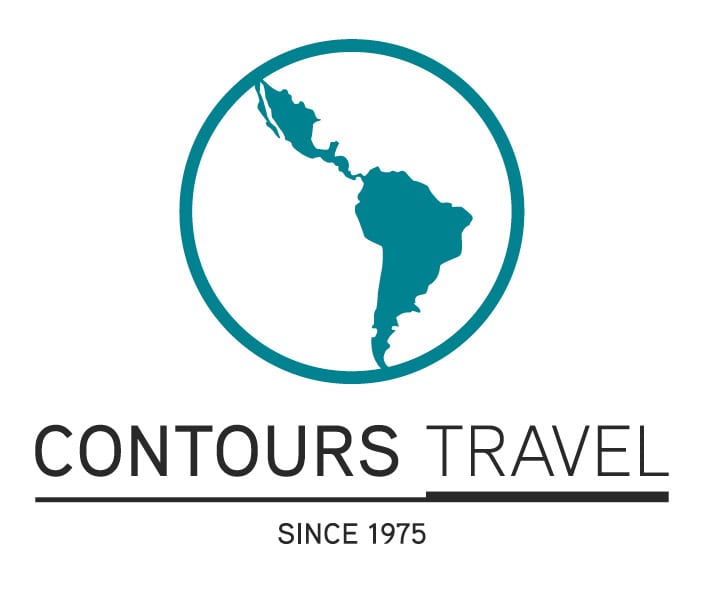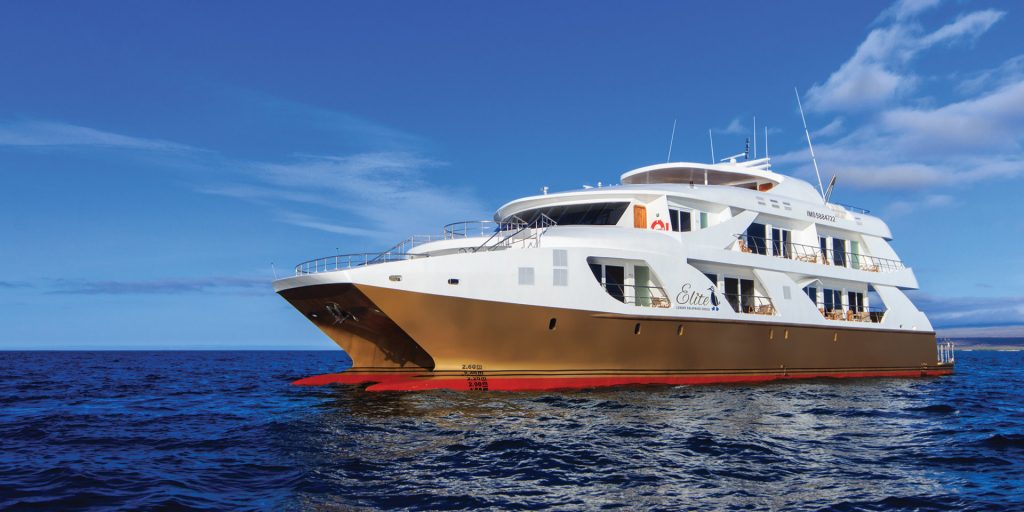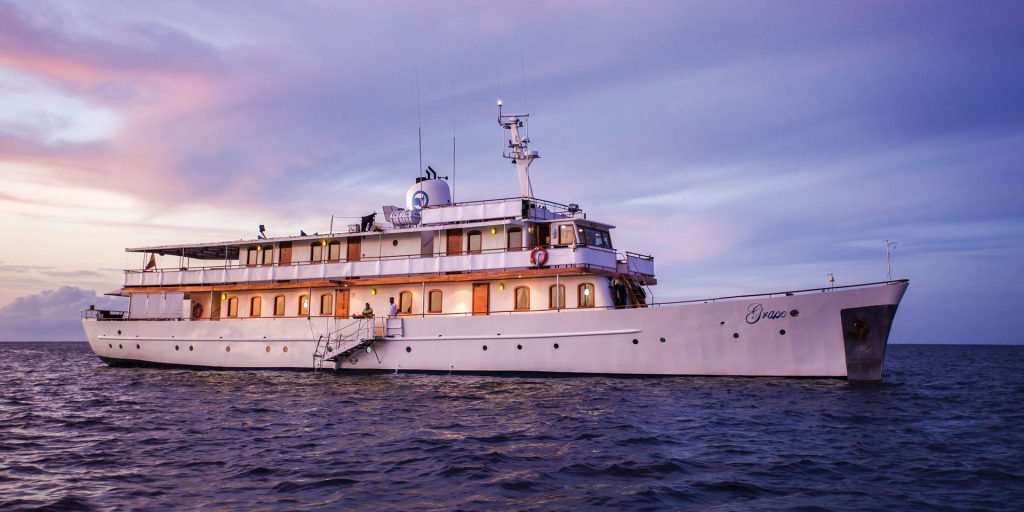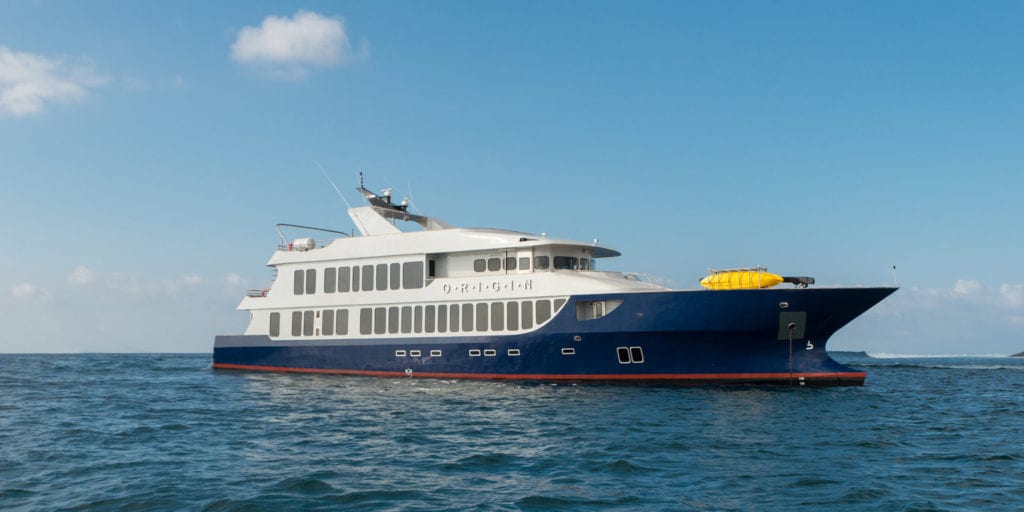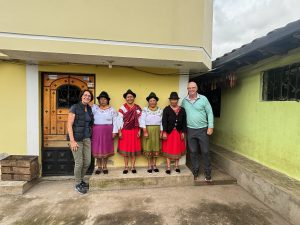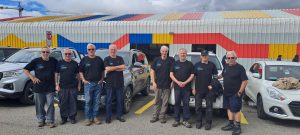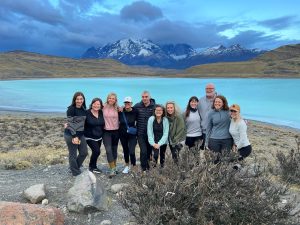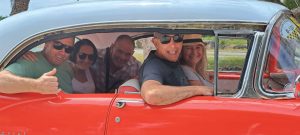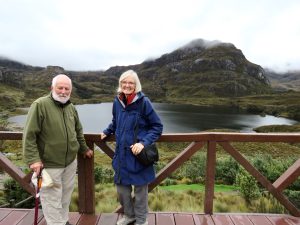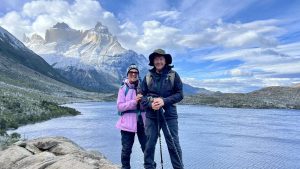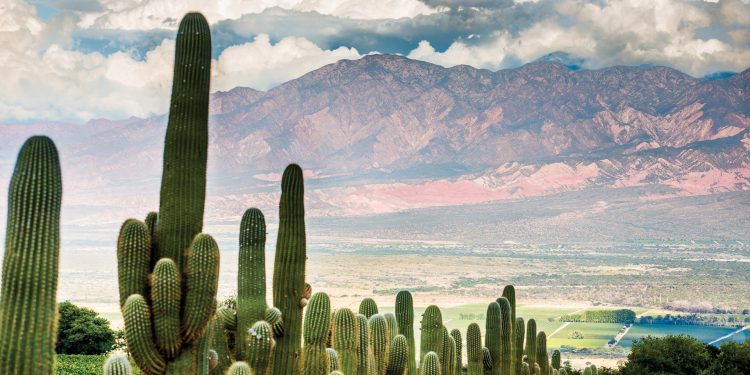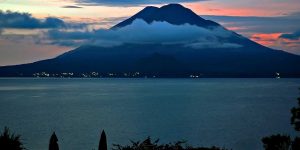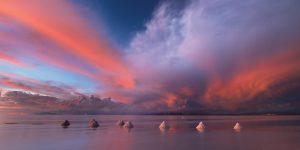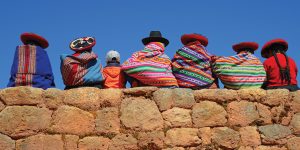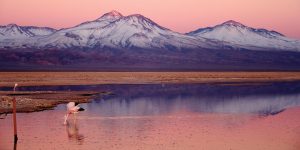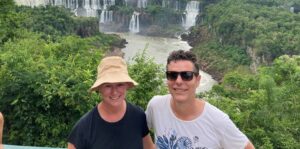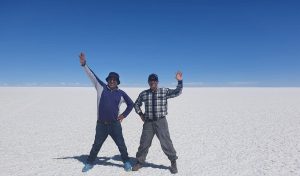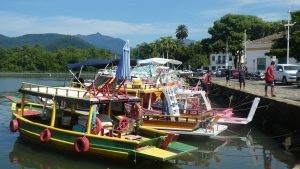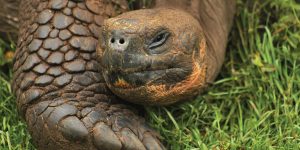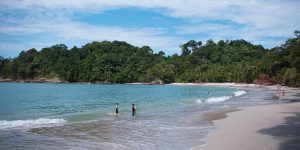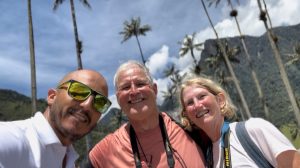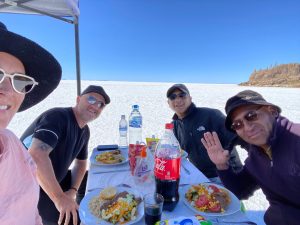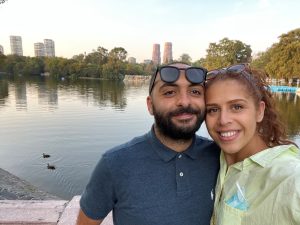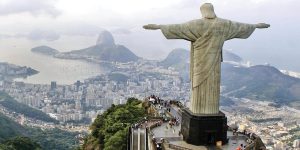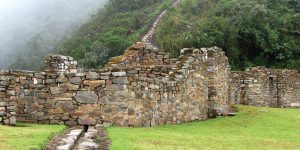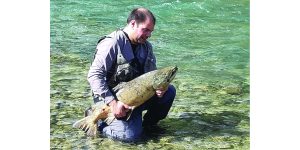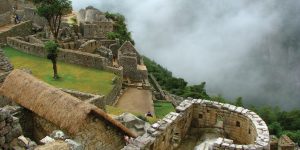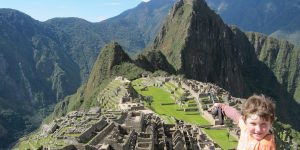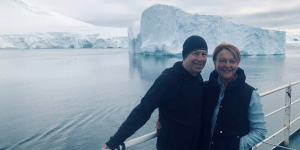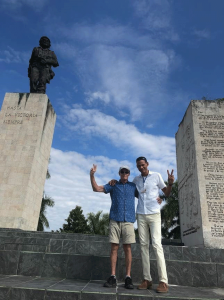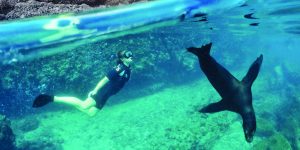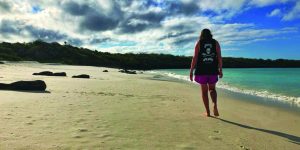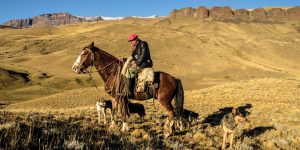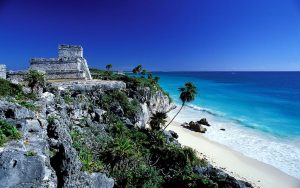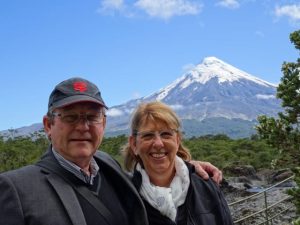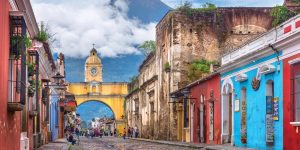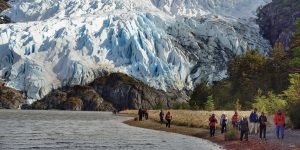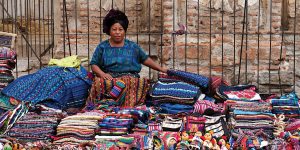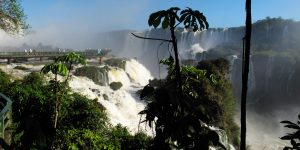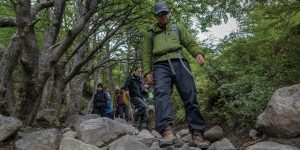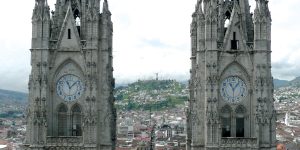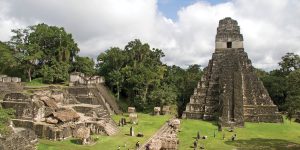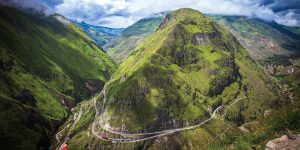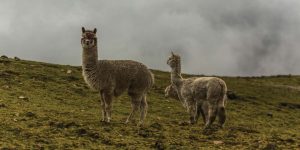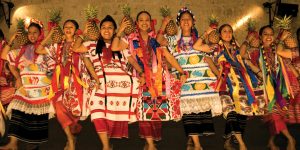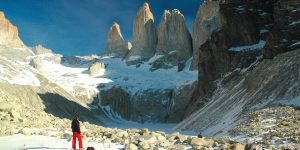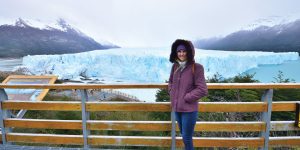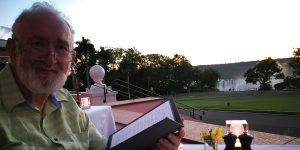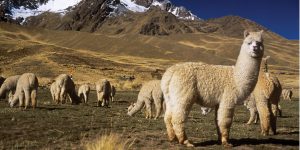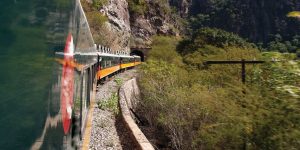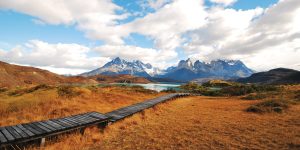Day 1 Santa Cruz Isl./Galapagos Islands
On arrival in Baltra, you will be picked up at the airport by a naturalist guide, and taken on a ten-minute bus drive to the pier to board the M/V Evolution where you will have lunch. Please remember that the exact route and program may vary according to weather and ocean conditions and the wildlife we encounter.
There are two types of landings throughout your Galapagos tour:
Dry landing: guests step from the dinghy onto rocks or a dock.
Wet landing: as the dinghy edges onto a sandy beach, guests step into knee-deep water and wade ashore.
PM: Bahia Borrero & Daphne Minor – Glide through emerald mangroves teeming with life in a gentle dinghy ride. This haven of white sand and turquoise waters whispers secrets of the deep – watch sea turtles weave through coral reefs, reef sharks patrol silently, and tropical fish dart in rainbow bursts. Across the bay, Daphne Minor, a silent sentinel rising from the waves, holds the echo of Darwin’s legacy. The Grants’ 20-year finch study, immortalized in “The Beak of the Finch,” unfolded here, forever linking this island to evolution’s grand story. Celebrate your first equatorial sunset with a welcome cocktail, followed by your first briefing and dinner. Tonight, you will set out for the western islands.
Day 2 Fernandina Isl./Galapagos Islands
AM: Punta Vicente Roca- visit the northern tip of Isabela, the largest island in the archipelago. Your first visit is to Punta Vicente Roca, a dive class snorkelling site. Marine life is incredible in these nutrient-rich waters of the Humboldt Current, that bathe the western side of the archipelago. A panga ride takes you on a tour of seabirds perched atop cliffs and in crevices; all beneath the towering cutaway of Volcano Ecuador, created when its flank slid into the ocean.
PM: Punta Espinosa- as you cross the Bolivar channel toward Fernandina, La Cumbre volcano, which erupts frequently (most recently in June 2018), looms large on the horizon. Next, you will visit Punta Espinosa, a narrow spit of land, where colonies of Godzilla-like Marine Iguanas, Sea Lions, Flightless Cormorants, and Galapagos Penguins live near one another. A hike across a cracked Pahoehoe lava field arrives at an aquarium-like Mangrove pond; home to Sea Turtles and Rays.
Day 3 Isabela Isl./Galapagos Islands
AM: Urbina Bay- is directly west of Isabela’s Volcano Alcedo, and you will make a smooth, wet landing (a hop into a few inches of water). Walk on a stretch of five km of the marine reef that has been uplifted by as much as four metres out of the water. A highlight of this excursion is the giant land iguanas and giant tortoises, as well as the opportunity to go snorkelling amongst marine creatures or just relax on the shore.
PM: Tagus Cove- where a wooden stairway rises to a trail entrance and continues around Darwin Lake through a dry vegetation zone, ending in a peninsula formed by spatter cones. The site provides spectacular views of Darwin and Wolf Volcanoes. Get ready for world-class snorkelling above the green, algae-rich, underwater pastures of Tagus Cove where you can encounter a herd of Sea Turtles, flocks of Penguins, Sea Lions, tropical fish, Flightless Cormorants and even Sea Horses.
Day 4 Bartolome Isl./Galapagos Islands
AM: Pinnacle Rock- visit Bartolome Island, famous for Pinnacle Rock, where you will see Galapagos Penguins and Sea Lions. Hike a trail to Bartolome’s summit for spectacular views of Pinnacle Rock, where the crystal blue waters of the bay cradle your yacht.
PM: Sullivan Bay- one of the most outstanding volcanic sites in the Galapagos. In the nearly 100 years since the Sullivan Bay Flow, only a few plants like Mollugo and Lava cacti have managed to take root in this harsh environment. Oyster-catchers can be seen fishing for crabs and molluscs in the tide pools of Sullivan Bay. After exploring the lava flow, there is swimming and snorkelling with playful Sea Lions off two small beaches.
Day 5 Rabida Isl./Galapagos Islands
AM: Las Bachas Beach- a sandy white-coral beach that is a major egg-laying site for sea turtles. The name Bachas refers to the remains of landing craft left here at the end of WWII. Ashore, marine iguanas mingle with flamingos and other wading birds in another of the many super saline lagoons found in the Galapagos.
PM: Rabida Island- also known by its English name of Jervis, is unique for the very red colour of the beach and cliffs, beneath which one can find gliding sea turtles and perched blue-footed boobies. A thick forest of Palo Santo trees sits back from the beach sheltering a yellow saltwater lagoon. Pelicans are next in the thickets and brightly coloured pink flamingos graze the lagoon. A sea lion colony likes to laze on the red sands of the beach. We hike up a tiny peninsula for a wonderful view of the beach and lagoon. Sea caves invite exploration further down the coast.
Day 6 Santa Cruz Isl./Galapagos Islands
AM: Pit Craters & Highlands- Santa Cruz beckons with volcanic wonders! Climb into the lost world of the Santa Cruz Highlands. Mossy forests cloak verdant hills, where sunlight dances on ancient ferns. Hike amidst Scalesia trees, home to Darwin’s finches and the flamboyant vermillion flycatcher. Track giant tortoises in their natural haven, their wrinkled faces and lumbering gait like living legends. Then, descend into another world – a labyrinthine lava tube carved by fiery rivers of molten rock. Explore this subterranean realm, darkness punctuated by flickering headlights, before emerging to the twin sinkholes of Los Gemelos. Gaze into these collapsed lava tubes, their stark beauty a testament to the island’s fiery past. Witness a contrast of landscapes – from sun-baked coast to verdant jungle – all within a stone’s throw. Santa Cruz whispers tales of ancient giants and volcanic landscapes, waiting to be unveiled.
PM: Charles Darwin Research Station- Step into the heart of Galapagos conservation. Here, passion meets science as you delve into the archipelago’s remarkable past and vibrant present. Witness the Giant Tortoise Breeding & Rearing Program, a beacon of hope for these gentle giants. Observe hatchlings, juveniles, and majestic adults, their wise eyes gazing serenely. Learn about Lonesome George, the last of his kind, and the tireless efforts to save his lineage. Immerse yourself in the station’s exhibits, each a gateway to understanding the fragile beauty of this island paradise. From tracking marine iguanas to glimpsing playful penguins, your visit becomes a personal journey of discovery, forever intertwined with the spirit of this exceptional research centre.
Day 7 Española Isl./Galapagos Islands
AM: Punta Suarez- is the southernmost island of the archipelago and is one of the most popular due to the breathtaking variation and number of fauna that inhabits it. Sea lions surf the waves, their pups greeting your arrival with curious snorts. Marine iguanas, in vibrant reds and blacks, bask in communal piles or cling to sun-warmed rocks. Masked boobies nest along the dramatic cliffs, while blue-footed boobies gather in a mesmerizing spectacle of turquoise feet. Lava gulls and doves flit through the air, sharing the space with marine iguanas, their eyes watching from atop the rocks. The trail leads to the island’s edge, where a blowhole shoots geysers into the air, a testament to volcanic power. And finally, the awe-inspiring moment – majestic, waved albatrosses, the largest birds of the Galapagos, launch from the cliffs, their wings spanning over seven feet. Witness their courtship dances and spot fluffy chicks hidden in nests, their future a promise on the wind. Punta Suarez – a breathtaking tapestry of life, woven on the edge of the world.
PM: Gardner Bay- Pristine white sand stretches into turquoise waters, inviting you to sink your toes and lose yourself in the rhythm of the waves. Sea lions laze under the sun, their playful pups waddling in curious circles. Snorkel among vibrant coral reefs, where playful young sea lions dart and pirouette alongside schools of shimmering fish – yellows, blues, and streaks of neon. White-tipped reef sharks doze on the sandy bottom, adding a touch of mystique to this underwater playground. Gardner Bay is more than just a beach – it’s a playground for nature’s playful spirits, a kaleidoscope of life dancing under the sun. So grab your mask, dive in, and let the magic of the Galapagos embrace you.
Day 8 Sat San Cristobal Isl.
AM: Kicker Rock and Interpretation Center- Rising from the emerald sea like a slumbering lion, Kicker Rock beckons. Once a fiery volcanic cone, time and tide have carved this giant into a haven for Galapagos wonders. Blue-footed boobies pirouette on its cliffs, their turquoise feet flashing in the sun. Frigatebirds soar overhead, their scarlet throats puffed in displays of dominance. Playful sea lions bark from sun-drenched shores, while red-billed tropicbirds weave through the air like feathered darts. Snorkel beneath the rock’s shadow, where shimmering fish dance past coral castles and graceful sharks patrol the depths. Kicker Rock – a testament to nature’s artistry, a vibrant oasis teeming with life.
Dive into the heart of the Galapagos at the Interpretation Centre. Journey through time, from fiery volcanic origins to diverse ecosystems teeming with life. Discover the islands’ unique flora and fauna, brought to life through interactive exhibits and captivating stories. Learn how humans have shaped and been shaped by this fragile paradise. Ascend Frigate Bird Hill, where magnificent and great frigates puff their chests and inflate red pouches, reminding you of nature’s endless drama. Leave with a deeper understanding of the Galapagos, its delicate balance, and the vital role we play in its future. This centre, a stage for nature’s wonders and human resilience, becomes your final whisper goodbye to these enchanting islands. After this visit, transfer to the airport for your ongoing flight.

